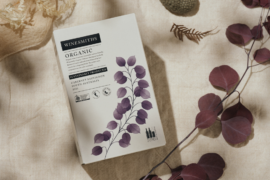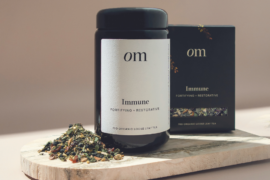Cooking with Autumnal produce
Autumn produce is bursting with flavour and colour. Discover how to make the most of seasonal fruits and vegetables with our cooking guide — plus three delicious warming recipes.
Autumn is a time of sheer abundance: a vibrant season bursting with colour and flavour. It’s no surprise that many chefs claim autumn is their favourite season of the year, as they reap the rewards of their sumptuous harvest, which ripens and develops in the warmth of summer. The peak of the summer heat gives way to cooler, crisper days and the days gradually shorten to make room for longer nights. This is the season to say goodbye to summer stone fruits and berries and say hello to an abundance of apples, pears, figs and nuts that are bursting forth right under your nose.
When it comes to cooking, it’s important to eat with the seasons. Not only is it better for the environment, but it also supports local communities and benefits your purse, too. Produce that is in season will be harvested at its peak at the time of ripening, making it ideal for cooking because it is full of nutrition and fl avour. As long as you’re buying local, the produce has fewer food miles since it minimises travel time between farm to plate, whereas produce that is not in season is often harvested before the full ripening process has occurred. These fruits and vegetables are often stored and cooled to slow the ripening process, before they are transported to stores and are available for sale.
To eat smart, it’s essential to know when produce is at its peak throughout the year so you can shop seasonally whenever possible. Of course, there are regional differentiations, so this is a broad guide only. Even in autumn there are seasons within seasons and different months see the peak of different produce. The early harvest in March is full of the likes of plums, peas, apples, figs and persimmons, while April sees wild mushrooms and nuts flourish. The late autumnal harvest is different again, boasting plenty of gourmet goodies like quinces, carrots, celery, parsnips, rhubarb and Brussels sprouts. If you can’t grow your own at home, your local farmers’ market is a great place to experiment with different produce and find out what’s in season.
Whether you’re making a pumpkin pie or an apple cobbler, here’s a guide to some of the best gourmet goodies you can enjoy during the autumn harvest.
Apples
Although apple season in Australia officially starts in summer, autumn is the peak of the season. This is the perfect time to experiment with different varieties of apples, all of which boast different flavour profiles and textures. The harvest starts with the Royal Gala (usually available from February), quickly followed by the Fuji, Golden Delicious, Jonathan, Granny Smith and Pink Lady. One of the newest members of the apple family to hit shelves recently is the Jazz Apple, a cross between the Braeburn and Gala, which is deliciously crunchy and sweet. Next time you shop, look for firm apples without bruises. Good storage in a cool, dark place is also essential to keep apples crisp, since warm and humid temperatures usually cause them to turn stodgy and soft. Alternatively, experience picking apples straight from the source at your local orchard: those on the outside of the tree are usually the ripest.
Apples are an ideal snack but are wonderful baked in comfort food like apple pies, muffins and strudels or gently poached on top of your morning porridge. On the savoury side, apple pairs beautifully with roast pork or a crisp textural side like a slaw. They also make an ideal stuffing for your next roast chicken or Christmas turkey.
Sweet potatoes
This nutritious superfood is a popular vegetable all year round; however, they shine the most in autumn when they are plentiful and sourced locally. Kumara, known for its orange skin, is the most popular variety, but it’s worth experimenting with lesser-known types like the heirloom, white and red sweet potatoes. It’s best to select sweet potatoes that look fi rm, are as smooth as possible and have an evenly coloured skin. Like apples they are best stored in a dark, dry place.
Sweet potatoes are one of the most versatile vegetables going around: they are delicious steamed, roasted, mashed and stuffed. Try cutting them into thin slices and layering them in an oven-baked gratin, baked into wedges with a little sea salt, pan-fried as fritters or just simply roasted in the oven with a sticky maple glaze. They are also delicious in an autumnal soup, in a coconut curry or stuffed with chickpeas as “jacket potatoes” drizzled with a tahini dressing.
Quinces
Hail the humble quince! These “golden apples” of Greek mythology are one of the earliest known fruits. They look a little like a cross between an apple and a pear, but their similarities stop there. Unlike apples and pears, quinces are generally inedible raw even when ripe. The beauty of quince lies in its sweet fragrance when it’s cooked as its hard flesh softens, gently blushes and becomes beautifully sweet.
Quinces can be used for so much more than just an accompaniment on a cheese platter. Since quinces have a high pectin content, a naturally occurring starch, they are ideal for pastes, jams and jellies. Try slow cooking, baking or pickling them in honey. One of the easiest ways to cook with quinces is poaching them in a delicious blend of spices and a touch of honey. On the savoury side, quince pairs beautifully with meaty dishes including lamb, turkey and duck. For the ultimate autumnal comfort food, substitute the usual apples with quinces in your next crumble or cobbler.
Pears
The falling of autumnal leaves also celebrates the start of the pear season. Sweet and tender William pears are usually the first pears to ripen in the season, followed by the brown Beurre Bosc and Packham. Don’t ignore the lesser-known pears which shine in their
own right including the Nashi and Corella, a small pear with a sweet flavour. Choose pears that are fi rm and slightly swollen and plump in appearance — they are usually the juiciest.
If eaten at the right time, pears are juicy and delicious to eat on their own. They are also the perfect accomplice for a flaky filo tart, galette or upside-down cake. Try poaching them with brown sugar, cinnamon and saffron and serve them on a bed of mascarpone, or for a simple show-stopping dessert, poached in red wine or cranberry to achieve the most beautiful reddish/purple hue. On the savoury side, try serving them with rocket and parmesan in a salad or teamed with gorgonzola and caramelised onion on a home-baked pizza. Nashi pears are perfect for Asian cuisine, in a salad or a crispy slaw.
Figs
Is there anything sweeter than biting into the soft flesh of a fig on
a crisp autumnal day? The limited season of the fig makes it so much more tempting. Figs are abundant during autumn and are
packed full of vitamins and minerals.
Figs can be eaten raw and are equally delicious poached or baked. Add them to a salad complemented by buffalo mozzarella and prosciutto with a drizzle of balsamic dressing, or on a wood-fired pizza with gorgonzola. On the sweeter side, they are lovely accompaniment to a panna cotta with a drizzle of honey, or to naturally sweeten your morning porridge or muesli.
Mushrooms
If you haven’t already, autumn is the time to jump on the mushie
bandwagon. Get experimental and work your way through the different varieties of wild mushrooms ranging from Porcini and Slippery Jacks to Milk Caps. Nothing screams autumn more like mushroom picking! Scrub up on your mushroom knowledge and experience picking mushrooms first-hand with some foraging — just be sure to take an expert with you so you don’t pick the poisonous ones.
Mushrooms are particularly popular for a plant-based diet, since they are a great alternative to meat due to their “meaty” texture and umami profile. They are perfect for comfort cooking and are delicious grilled, sautéed and oven-baked. Think mushrooms braised in a white wine and garlic sauce on a luscious bed of pappardelle or polenta, wild mushroom risotto with shaved parmesan and truffle or just roasted or pan-fried with a splash of extra-virgin olive oil.
Persimmons
Unfortunately, persimmons are one of the most overlooked fruits.
But this not-so-trendy fruit is so versatile for both sweet and savoury recipes. There are two main varieties: the original persimmon, well known to older generations, is a large heart-shaped fruit, ranging in colour from pale to a deeper orange; and the sweet persimmon, also known as the Fuyu Fruit, is round with a slightly flattened top. The original version is far too astringent when eaten too early and needs to be harvested once fully ripened when the fl esh is soft and sweet. The sweet persimmon is a non-astringent version and can be eaten when crisp and crunchy and has an edible peel.
This fruit can be eaten like an apple or whipped up in a homemade
jam or compote or added to a cake or even bread. It provides a lovely texture and sweetness in an autumnal salad.
Pumpkins
From the sweet butternut pumpkin to the big Queensland blue,
pumpkins are abundant in autumn and are a must-have in your
kitchen pantry. Is there anything more comforting than a big bowl
of pumpkin soup on a crisp autumnal day? Think beyond pumpkin
soup and get creative in the kitchen: pumpkin-stuffed ravioli with
burnt butter and sage, pumpkin pie and whole pumpkins stuffed
with lentils, nuts and a myriad of spices.
Pumpkin is usually reserved for savoury dishes, but get experimental and try a pumpkin pie or even pumpkin-spiced
muffins or cookies. The list is endless.




